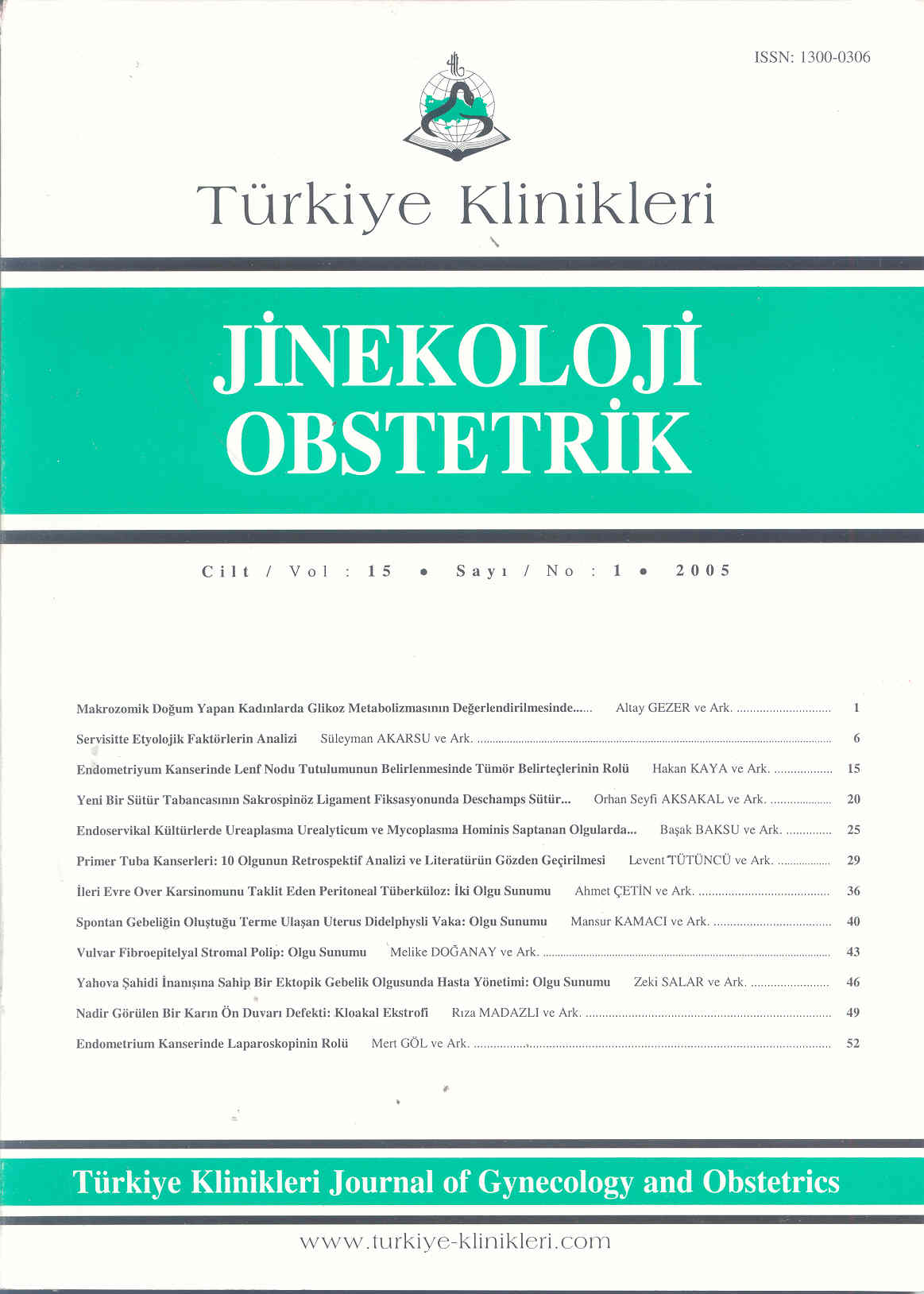Open Access
Peer Reviewed
ORIGINAL RESEARCH
3332 Viewed1142 Downloaded
Analysis Of Responsible Factors In The Etiology Of Cervicitis
Servisitte Etyolojik Faktörlerin Analizi
Turkiye Klinikleri J Gynecol Obst. 2005;15(1):6-14
Article Language: TR
Copyright Ⓒ 2025 by Türkiye Klinikleri. This is an open access article under the CC BY-NC-ND license (http://creativecommons.org/licenses/by-nc-nd/4.0/)
ÖZET
Amaç: Çalışmamızda servikal enfeksiyonların etyolojisini etkileyen faktörleri ve tanıda kullanılan yöntemlerin geçerliliğini belirlemeyi amaçladık. Gereç ve Yöntemler: Jinekoloji polikliniğine başvuran üç grup hasta çalışmaya alınmıştır. Lökore şikayeti ile jinekoloji polikliniğine başvuran 100 hasta; jinekoloji polikliniğine rutin takip amaçlı başvuran ve kronik servisit bulunan 100 hasta ve seksüel geçişli hastalıklar polikliniğine başvuran 100 hasta analiz edilmiştir. Servikal enfeksiyonlara yakalanma sıklığını artırabilecek etkenler (yaş, eğitim düzeyi, korunma yöntemleri, partner sayısı, geliş şikayeti, muayene bulguları) sorgulanmıştır. Etyoloji de sıklıkla suçlanan Nesseria Gonorrhea (N. Gonorrhea), Clamidya Trachomatis (C. Trachomatis), Ureaplasma Urealyticum (U Urealyticum) ve Mycoplasma Hominis (M. Hominis) araştırılmıştır. Çukolata Agar, Thayer-Martin besi, Direkt Flouresans Antibody testi ve Mycoplasma IST, Chlamyfast testi kullanılmıştır. Bulgular: Çalışmada incelenen 300 hasta içinde 28 tane (%9.3) M. Hominis, 27 tane (%9) U. Urealyticum olmak üzere toplam 55 mycoplasma enfeksiyonu, 20 (%6,3) tane N. Gonorrhea ve 16 (%5,3) tane C. Trachomatis enfeksiyonu tespit edilmiştir. Sonuç: N. Gonorrhea genital enfeksiyon saptanma oranı ile seksüel eş sayısı ve düşük eğitim düzeyi arasında istatiksel olarak bir ilişki vardır. C. Trachomatis ve N. Gonorrhea enfeksiyonlarının 15-25 yaş gubunda saptanma oranı daha fazladır. OKS kullananlarda, C. Trachomatis genital enfeksiyonu saptanma oranı daha yüksektir. İstatistiksel olarak M. Hominis genital enfeksiyonları düşük eğitim düzeyi ve seksüel eş sayısı ile ilişkilidir.
Amaç: Çalışmamızda servikal enfeksiyonların etyolojisini etkileyen faktörleri ve tanıda kullanılan yöntemlerin geçerliliğini belirlemeyi amaçladık. Gereç ve Yöntemler: Jinekoloji polikliniğine başvuran üç grup hasta çalışmaya alınmıştır. Lökore şikayeti ile jinekoloji polikliniğine başvuran 100 hasta; jinekoloji polikliniğine rutin takip amaçlı başvuran ve kronik servisit bulunan 100 hasta ve seksüel geçişli hastalıklar polikliniğine başvuran 100 hasta analiz edilmiştir. Servikal enfeksiyonlara yakalanma sıklığını artırabilecek etkenler (yaş, eğitim düzeyi, korunma yöntemleri, partner sayısı, geliş şikayeti, muayene bulguları) sorgulanmıştır. Etyoloji de sıklıkla suçlanan Nesseria Gonorrhea (N. Gonorrhea), Clamidya Trachomatis (C. Trachomatis), Ureaplasma Urealyticum (U Urealyticum) ve Mycoplasma Hominis (M. Hominis) araştırılmıştır. Çukolata Agar, Thayer-Martin besi, Direkt Flouresans Antibody testi ve Mycoplasma IST, Chlamyfast testi kullanılmıştır. Bulgular: Çalışmada incelenen 300 hasta içinde 28 tane (%9.3) M. Hominis, 27 tane (%9) U. Urealyticum olmak üzere toplam 55 mycoplasma enfeksiyonu, 20 (%6,3) tane N. Gonorrhea ve 16 (%5,3) tane C. Trachomatis enfeksiyonu tespit edilmiştir. Sonuç: N. Gonorrhea genital enfeksiyon saptanma oranı ile seksüel eş sayısı ve düşük eğitim düzeyi arasında istatiksel olarak bir ilişki vardır. C. Trachomatis ve N. Gonorrhea enfeksiyonlarının 15-25 yaş gubunda saptanma oranı daha fazladır. OKS kullananlarda, C. Trachomatis genital enfeksiyonu saptanma oranı daha yüksektir. İstatistiksel olarak M. Hominis genital enfeksiyonları düşük eğitim düzeyi ve seksüel eş sayısı ile ilişkilidir.
ANAHTAR KELİMELER: Servisit, etyoloji, tanı yöntemleri
ABSTRACT
Objective: We aimed to investigate causes of cervicitis and to demonstrate validity of the diagnostic methods in cervical infections. Material and Methods: Three groups of patients were included in the study. One hundred patients with vaginal discharge, 100 patients with chronic cervicitis and 100 patients who admitted the sexually transmitted disease out-patient clinic were analyzed. The factors that increase the frequency of the cervical infections (age, education, contraceptive methods, number of sexuel partners, findings in gynecologic examination, etc) were investigated. Cervical specimens were examined with direct microscopy. N. Gonorrhea ve C. Trachomatis, Ureaplasma Urealyticum, M. Hominis which were frequently found in cervical infections were explored. Chocolate Agar, Thayer-Martin culture, Direct Flourescense Antibody test, Mycoplasma IST, and Chlamyfast test were used for the diagnosis of cervicitis etiology. Results: Totally 28 (9.3%) patients with M. Hominis, 27 (9%) patients with U. Urealyticum, 20 (6,3%) patients with N. Gonorrhea and 16 (5,3%) patients with C. Trachomatis genital infections were detected. Conclusion: Diagnosis of N. Gonorrhea genital infection was increased with multiple sexual partners and low educational level. C. Trachomatis and N. Gonorrhea genital infections were more frequently diagnosed in 15-25 ages. C. Trachomatis genital infections were mostly found in women who used combined oral contraceptive drugs as a contraceptive method. M. Hominis genital infections were mostly seen in women with low educational level and multiple sexual partners.
Objective: We aimed to investigate causes of cervicitis and to demonstrate validity of the diagnostic methods in cervical infections. Material and Methods: Three groups of patients were included in the study. One hundred patients with vaginal discharge, 100 patients with chronic cervicitis and 100 patients who admitted the sexually transmitted disease out-patient clinic were analyzed. The factors that increase the frequency of the cervical infections (age, education, contraceptive methods, number of sexuel partners, findings in gynecologic examination, etc) were investigated. Cervical specimens were examined with direct microscopy. N. Gonorrhea ve C. Trachomatis, Ureaplasma Urealyticum, M. Hominis which were frequently found in cervical infections were explored. Chocolate Agar, Thayer-Martin culture, Direct Flourescense Antibody test, Mycoplasma IST, and Chlamyfast test were used for the diagnosis of cervicitis etiology. Results: Totally 28 (9.3%) patients with M. Hominis, 27 (9%) patients with U. Urealyticum, 20 (6,3%) patients with N. Gonorrhea and 16 (5,3%) patients with C. Trachomatis genital infections were detected. Conclusion: Diagnosis of N. Gonorrhea genital infection was increased with multiple sexual partners and low educational level. C. Trachomatis and N. Gonorrhea genital infections were more frequently diagnosed in 15-25 ages. C. Trachomatis genital infections were mostly found in women who used combined oral contraceptive drugs as a contraceptive method. M. Hominis genital infections were mostly seen in women with low educational level and multiple sexual partners.
MENU
POPULAR ARTICLES
MOST DOWNLOADED ARTICLES





This journal is licensed under a Creative Commons Attribution-NonCommercial-NoDerivatives 4.0 International License.










